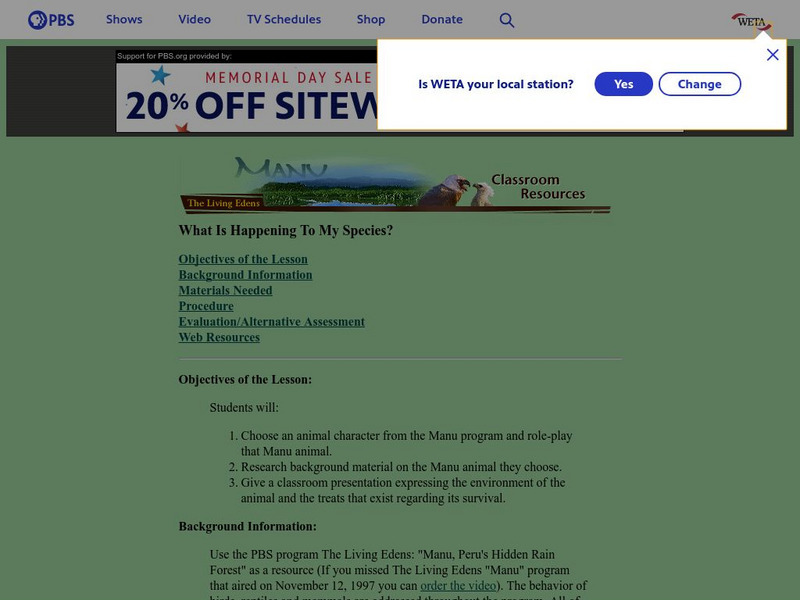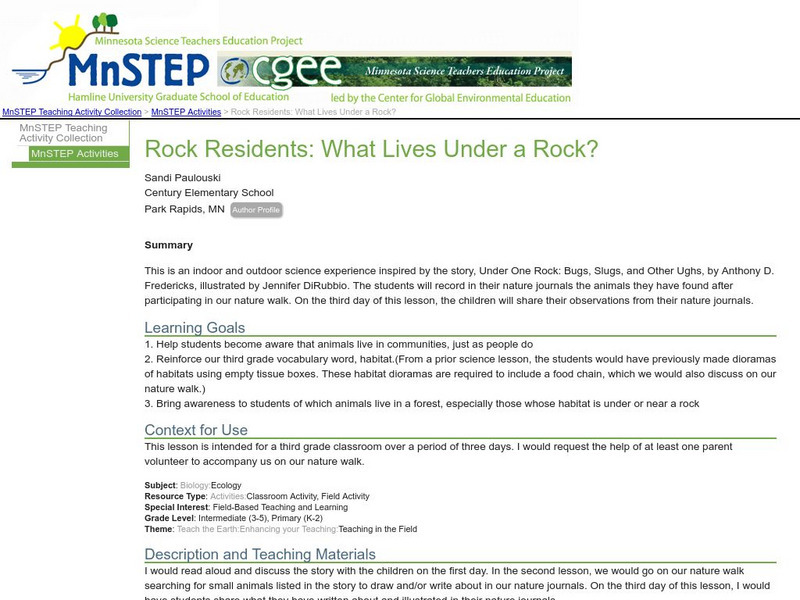Other
Welcome to Biodiversity Hotspots
Conservation International offers this extensive look at some of earth's most vulnerable areas. Some of the most remarkably diverse places in the world also prove to be some of the most threatened. Learn more about the efforts in place...
Other
Switch Zoo: Where Do I Live?
In these games, you will move the animals who live in Switch Zoo to their original home continent or ocean.
ClassFlow
Class Flow: Animal Adaptation
[Free Registration/Login Required] Students will investigate the habitats of different organisms and the dependence of organisms on their habitat and recognize that organisms have specific traits that help them adapt so they can carry...
PBS
Pbs Teachers:manu: What's Happening to My Species?
Learn about animals from Manu, create a mask depicting a selected animal and role play that animal. Discuss the selected animals and the threats to their survival in the Manu rainforest.
PBS
Pbs Learning Media: Gila Monster
This video segment from Outdoor Nevada looks at the Gila monster's behavior, habitat, and unique adaptive characteristics. [3:55]
PBS
Pbs Kids: Plum Landing: Plum's Creature Connector
This PBS Kids activity is an extension of a Plum Landing episode featuring food webs. Students will learn basic information about how animals are interdependent. Students will help different animals survive in their different habitats
Science Struck
Science Struck: Arabian Desert Facts
Presents interesting information about the Arabian Desert, including its physical geography, climate, plants and animals, their adaptations to the environment, natural resources, and threats to its habitats.
TeachEngineering
Teach Engineering: Environments and Ecosystems
Students explore the biosphere and its associated environments and ecosystems in the context of creating a model ecosystem, learning along the way about the animals and resources. Students investigate different types of ecosystems, learn...
Science Education Resource Center at Carleton College
Serc: Interdependence of Life: How an Ecosystem Responds to Change
In this biology field investigation, learners will investigate the site of an environmental disturbance, identify plant and animal life within that specific area, and compare it to an adjoining forested area. Students will map both areas...
Science Education Resource Center at Carleton College
Serc: Virtual Inquiry Field Lesson
Students use inquiry skills to answer their own questions about an area's animals in a natural setting using motion sensing video cameras.
Other
The Antlion Pit: A Doodlebug Anthology
Outlines the physical characteristics of the antlion order, Neuroptera. Identify them by their size, relationships with other animals, and about the antlion's role in certain cultures.
CK-12 Foundation
Ck 12: Life Science: Terrestrial Biomes
[Free Registration/Login may be required to access all resource tools.] A terrestrial biome is an area of land with a similar climate that includes similar communities of plants and animals. Different terrestrial biomes are usually...
Ducksters
Ducksters: Birds for Kids
Kids learn about birds and their habitats and different types. What makes an animal a bird? How do they fly?
The BIG zoo
The Big Zoo: Honey Bee
Site provides some fascinating facts regarding these extremely important insects. Contains a physical; description, information regarding their diet, habitat, social structure, birth and offspring as well as senses.
The BIG zoo
The Big Zoo: Saltwater Crocodile
Virtual zoo site provides some fascinating facts on this largest living reptile. Contains a physical description as well as information on their habitat, diet, social structure and birth and offspring.
EL Education
El Education: Local Habitat Survey and Animal Research
Students observe animals in several habitats and then choose one animal to research. Students learn about physical adaptations that help each animal live successfully in its habitat and then draw a picture of their animal which is later...
Science Education Resource Center at Carleton College
Serc: Mn Step: Rock Residents: What Lives Under a Rock?
For this activity, learners first listen to a story about animals that live under rocks, then go on an exploratory nature walk to see what animals they can find, living in their own small habitats. They write about their discoveries in a...
ClassFlow
Class Flow: Understanding Ecosystems: Climate Part 2 of 4
[Free Registration/Login Required] This flipchart will help students understand how climate affects our ecosystems. Links are provided to further their knowledge of the types of plants and animals that live in different climate zones.
HotChalk
Hot Chalk: Lesson Plans Page: Majestic Peaks
In this lesson, students research plant and animal life on mountains, as well as different weather regions. They then work in groups to present their information to the class.
EL Education
El Education: A Walk Through Highland Park
This book was created by 2nd grade students in Rochester, New York as part of a three-month learning expedition on animals and habitats called, "A Walk Through Highland Park. Students spent time in their local park doing fieldwork making...
Other
Nh F&w: Nongame and Endangered Wildlife Program
New Hampshire offers a problem/solution section of their conservation page that illustrates wildlife management challenges in varied habitats.
ClassFlow
Class Flow: Where Do They Live?
[Free Registration/Login Required] This flipchart contains an introduction page through which teachers can discuss what all living things need. On subsequent pages students will decide which animal does not belong in the habitat shown.
Encyclopedia of Earth
Encyclopedia of Earth: Evolutionary Biology: Amphibian Ecology and Evolution
Information about amphibians, animals that can survive in a wide variety of habitats and cli-ates. The article discusses their behavior, diet, predators, conservation status, and evolution. (Published: August 29, 2008)
Alabama Learning Exchange
Alex: Camouflage Predation Challenge
Through this simulation, learners will understand the role of camouflage in keeping animals from attracting attention of their predators. Using newspaper and patterned wrapping paper, students will construct two habitats. Learners will...




















